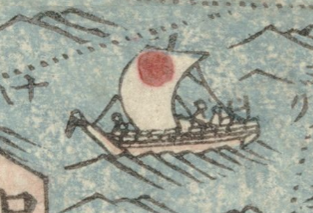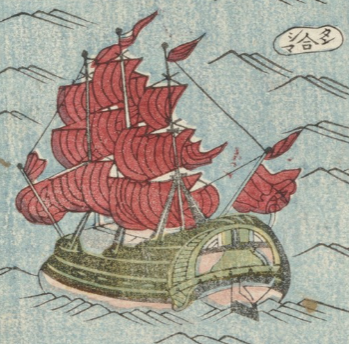Map pictures


A japanese ship (top) and a Dutch ship (bottom). Image sections from 'Detailed itinerary map of great Japan'.
Solution 2
There are five smaller sailing boats and two larger ships, one equipped with two masts and one with three respectively. You may specify them further, by comparing them for instance with the ships in the ‘map of the world’ (bankoku sōzu) (held by the National Diet Library Tokyo). As the captions in this latter map suggest, it shows from the top right in clockwise direction: a ‘Great-Ming’, ‘Japanese’, ‘Southern Barbarian’ (nanban) and a ‘Dutch ship’.
The five smaller sailing boats in our travel map are obviously Japanese coasters. Again, the junk, sailing between Iki and Tsushima, has sails folded crosswise, like the ‘Southern Barbarian ship’ in the ‘map of the world’. It is also remindful of pictures of two-masted ‘red seal ships’ (shuin-sen), which conducted trade between Nagasaki and South East Asian ports in the early seventeenth century. But in the mid-nineteenth century, neither did Portuguese nor Spanish ships sail to Japanese coasts, nor was the red seal system in effect anymore. The ship refers to the trade, conducted between Tsushima domain and Korea during the Edo period.
Finally, the three-masted ship, about to enter Nagasaki, is a more ornamental version of the ‘Dutch ship’ in the ‘map of the world’. It is also remindful of the pictorial tradition of ships in European early modern maps, such as in the Iaponiae nova descriptio (held by the Bibliothèque nationale de France). It thus likely refers to a Dutch frigate.
In summary, the five smaller sailing ships mark inland sea routes, and the ships, with two and three masts respectively, mark foreign sea routes. A closer look at pictures in maps thus reveals their importance as codes. If you want to learn more about the different ships, sailing on Asian seas in the early modern period, visit the database of pictures and maps of the Museum of Maritime Science.
